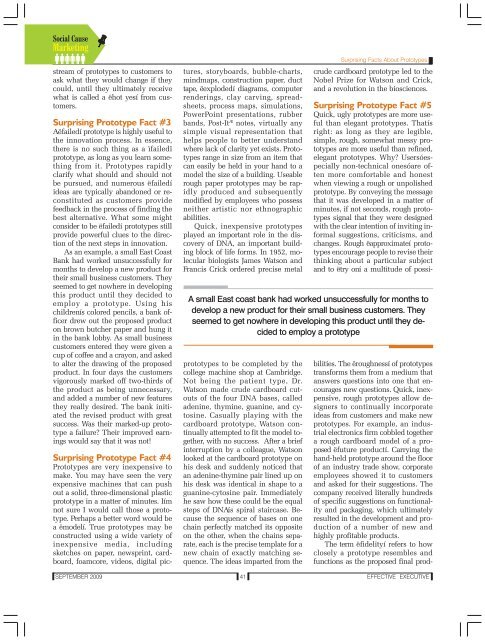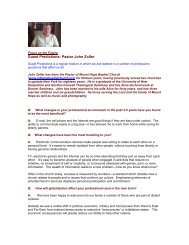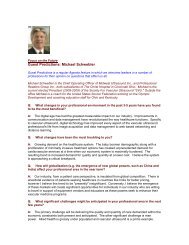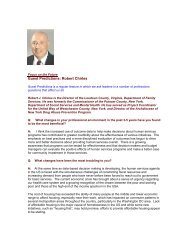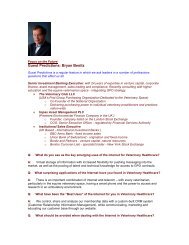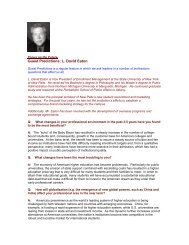Social Cause Marketing - The Regis Group Inc
Social Cause Marketing - The Regis Group Inc
Social Cause Marketing - The Regis Group Inc
You also want an ePaper? Increase the reach of your titles
YUMPU automatically turns print PDFs into web optimized ePapers that Google loves.
stream of prototypes to customers to<br />
ask what they would change if they<br />
could, until they ultimately receive<br />
what is called a ëhot yesí from customers.<br />
Surprising Prototype Fact #3<br />
A ëfailedí prototype is highly useful to<br />
the innovation process. In essence,<br />
there is no such thing as a ìfailedî<br />
prototype, as long as you learn something<br />
from it. Prototypes rapidly<br />
clarify what should and should not<br />
be pursued, and numerous ëfailedí<br />
ideas are typically abandoned or reconstituted<br />
as customers provide<br />
feedback in the process of finding the<br />
best alternative. What some might<br />
consider to be ëfailedí prototypes still<br />
provide powerful clues to the direction<br />
of the next steps in innovation.<br />
As an example, a small East Coast<br />
Bank had worked unsuccessfully for<br />
months to develop a new product for<br />
their small business customers. <strong>The</strong>y<br />
seemed to get nowhere in developing<br />
this product until they decided to<br />
employ a prototype. Using his<br />
childrenís colored pencils, a bank officer<br />
drew out the proposed product<br />
on brown butcher paper and hung it<br />
in the bank lobby. As small business<br />
customers entered they were given a<br />
cup of coffee and a crayon, and asked<br />
to alter the drawing of the proposed<br />
product. In four days the customers<br />
vigorously marked off two-thirds of<br />
the product as being unnecessary,<br />
and added a number of new features<br />
they really desired. <strong>The</strong> bank initiated<br />
the revised product with great<br />
success. Was their marked-up prototype<br />
a failure? <strong>The</strong>ir improved earnings<br />
would say that it was not!<br />
Surprising Prototype Fact #4<br />
Prototypes are very inexpensive to<br />
make. You may have seen the very<br />
expensive machines that can push<br />
out a solid, three-dimensional plastic<br />
prototype in a matter of minutes. Iím<br />
not sure I would call those a prototype.<br />
Perhaps a better word would be<br />
a ëmodelí. True prototypes may be<br />
constructed using a wide variety of<br />
inexpensive media, including<br />
sketches on paper, newsprint, cardboard,<br />
foamcore, videos, digital pictures,<br />
storyboards, bubble-charts,<br />
mindmaps, construction paper, duct<br />
tape, ëexplodedí diagrams, computer<br />
renderings, clay carving, spreadsheets,<br />
process maps, simulations,<br />
PowerPoint presentations, rubber<br />
bands, Post-It Æ notes, virtually any<br />
simple visual representation that<br />
helps people to better understand<br />
where lack of clarity yet exists. Prototypes<br />
range in size from an item that<br />
can easily be held in your hand to a<br />
model the size of a building. Useable<br />
rough paper prototypes may be rapidly<br />
produced and subsequently<br />
modified by employees who possess<br />
neither artistic nor ethnographic<br />
abilities.<br />
Quick, inexpensive prototypes<br />
played an important role in the discovery<br />
of DNA, an important building<br />
block of life forms. In 1952, molecular<br />
biologists James Watson and<br />
Francis Crick ordered precise metal<br />
A small East coast bank had worked unsuccessfully for months to<br />
develop a new product for their small business customers. <strong>The</strong>y<br />
seemed to get nowhere in developing this product until they decided<br />
to employ a prototype<br />
prototypes to be completed by the<br />
college machine shop at Cambridge.<br />
Not being the patient type, Dr.<br />
Watson made crude cardboard cutouts<br />
of the four DNA bases, called<br />
adenine, thymine, guanine, and cytosine.<br />
Casually playing with the<br />
cardboard prototype, Watson continually<br />
attempted to fit the model together,<br />
with no success. After a brief<br />
interruption by a colleague, Watson<br />
looked at the cardboard prototype on<br />
his desk and suddenly noticed that<br />
an adenine-thymine pair lined up on<br />
his desk was identical in shape to a<br />
guanine-cytosine pair. Immediately<br />
he saw how these could be the equal<br />
steps of DNAís spiral staircase. Because<br />
the sequence of bases on one<br />
chain perfectly matched its opposite<br />
on the other, when the chains separate,<br />
each is the precise template for a<br />
new chain of exactly matching sequence.<br />
<strong>The</strong> ideas imparted from the<br />
Surprising Facts About Prototypes<br />
crude cardboard prototype led to the<br />
Nobel Prize for Watson and Crick,<br />
and a revolution in the biosciences.<br />
Surprising Prototype Fact #5<br />
Quick, ugly prototypes are more useful<br />
than elegant prototypes. Thatís<br />
right: as long as they are legible,<br />
simple, rough, somewhat messy prototypes<br />
are more useful than refined,<br />
elegant prototypes. Why? Usersóespecially<br />
non-technical onesóare often<br />
more comfortable and honest<br />
when viewing a rough or unpolished<br />
prototype. By conveying the message<br />
that it was developed in a matter of<br />
minutes, if not seconds, rough prototypes<br />
signal that they were designed<br />
with the clear intention of inviting informal<br />
suggestions, criticisms, and<br />
changes. Rough ëapproximateí prototypes<br />
encourage people to revise their<br />
thinking about a particular subject<br />
and to ëtry oní a multitude of possibilities.<br />
<strong>The</strong> ëroughnessí of prototypes<br />
transforms them from a medium that<br />
answers questions into one that encourages<br />
new questions. Quick, inexpensive,<br />
rough prototypes allow designers<br />
to continually incorporate<br />
ideas from customers and make new<br />
prototypes. For example, an industrial<br />
electronics firm cobbled together<br />
a rough cardboard model of a proposed<br />
ëfuture productí. Carrying the<br />
hand-held prototype around the floor<br />
of an industry trade show, corporate<br />
employees showed it to customers<br />
and asked for their suggestions. <strong>The</strong><br />
company received literally hundreds<br />
of specific suggestions on functionality<br />
and packaging, which ultimately<br />
resulted in the development and production<br />
of a number of new and<br />
highly profitable products.<br />
<strong>The</strong> term ëfidelityí refers to how<br />
closely a prototype resembles and<br />
functions as the proposed final prod-<br />
SEPTEMBER 2009<br />
41<br />
EFFECTIVE EXECUTIVE


